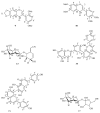Phytochemical Study of Aqueous Extract of Ochna schweinfurthiana F. Hoffm Powder Bark and Evaluation of Their Anti-Inflammatory, Cytotoxic, and Genotoxic Properties
- PMID: 30906417
- PMCID: PMC6398047
- DOI: 10.1155/2019/8908343
Phytochemical Study of Aqueous Extract of Ochna schweinfurthiana F. Hoffm Powder Bark and Evaluation of Their Anti-Inflammatory, Cytotoxic, and Genotoxic Properties
Abstract
Ochna schweinfurthiana has been used in traditional medicine to treat pain, inflammation, and arthritis. It is a rich source of complex dimers of flavonoids with potential use as templates for the development of therapeutic drugs. Hence, the aim of this study was to study the phytochemical content and evaluate the in vitro cytotoxic, genotoxic, and anti-inflammatory activities of the aqueous extract of Ochna schweinfurthiana bark (OSE). Phytochemical study was carried out according to LC-MS procedures, while isolation was carried out using thin layer and column chromatographies. Cytotoxicity was investigated by the mitochondrial viability [3-(4,5-dimethylthiazol-2-yl)-2,5-diphenyltetrazolium bromide] (MTT) method while genotoxicity potential of the extract was ascertained using the Salmonella typhimurium test strains TA98 and TA100. The anti-inflammatory effect of OSE was evaluated by the in vitro inhibition of 15-lipooxygenase enzyme and bovine serum albumin denaturation (BSA) assays. The investigation of compounds extracted from OSE led to the identification and isolation of six known compounds, namely, hemerocallone (9), 6,7-dimethoxy-3'-4'-dimethoxyisoflavone (10), lithospermoside (13), amentoflavone (14), agathisflavone (15), and β-D-fructofuranosyl-α-D-glucopyranoside (17). In the anti-inflammatory assay, aqueous extracts of the bark showed selective inhibition of 15-lipooxygenase with IC50 value of 32.2 ± 0.36 μg/mL and the result of the bovine serum albumin denaturation assay with IC50 value of 130± 5.78 μg/mL showed moderate activity. The toxicity assay indicated that OSE are noncytotoxic on Vero cell line with LC50 value of 50 mg/mL and nongenotoxic toward Salmonella typhimurium tester strain TA98 and TA100. Result from this study supports the traditional use of the selected medicinal plants in Cameroon for the treatment of inflammatory conditions. Noncytotoxicity and nongenotoxicity of OSE suggest that this plant is safe for use.
Figures






References
-
- Umapathy E., Ndebia E. J., Meeme, et al. An experimental evaluation of Albuca seroseae aqueous extract on membrane stabilization, protein denaturation and white blood cell migration during acute inflammation. Journal of Medicinal Plant Research. 2015;4(5):789–795.
-
- Kumar V., Bhat Z. A., Kumar D., Bohra P., Sheela S. In-vitro anti-inflammatory activity of leaf extracts of basella alba linn. var. alba. International Journal of Drug Development and Research. 2011;3(2):176–179.
LinkOut - more resources
Full Text Sources

